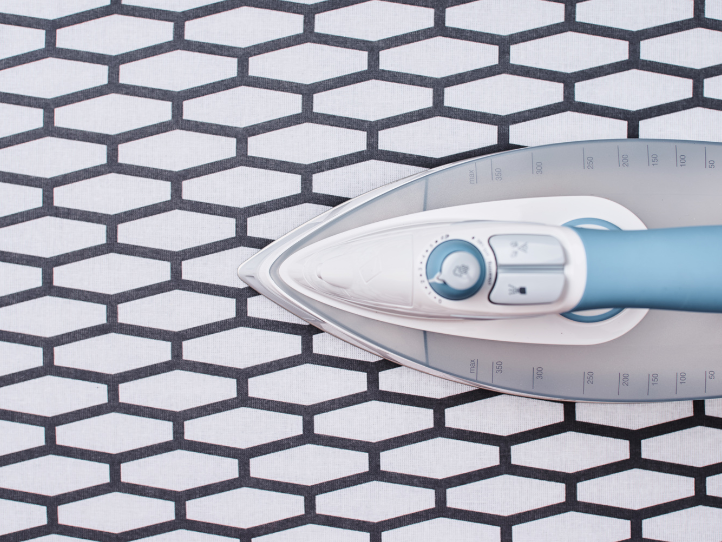
Wool pressing mats are a favorite tool among quilters for both their durability and ability to provide crisp and flat seams. Joy Heimark shares her knowledge of wool pressing mats with our readers in her newest article that talks about the ins and outs of this handy quilting tool. Joy has been selling wool pressing mats in her Etsy shop since 2019 and is sharing her expertise on selecting quality pressing mats, as well as general information for beginner quilters. If you’ve been considering purchasing a pressing mat, keep reading to learn everything you need to know about this quilting essential!
Why Wool Pressing Mats?
Over the years I’ve had many questions posed to me about my wool pressing mats, and wool pressing mats in general. These mats are used by quilters to cover pressing stations, tables, dressers, and other surfaces. Smaller mats are also used by other crafters for pinning and blocking smaller items, or as pin cushions and “parking” needles with various colors of embroidery thread. One member from our quilt guild suggested I write an article providing general information about wool pressing mats. I’ve been selling wool pressing mats since 2019. Before I started, I researched wholesale wool felt companies online to get more information and found there is a complete and regulated system for types of wool felt – thickness, density, color, and content. Each different category has a variety of suggested uses – acoustic panels, packaging, rug backing, saddle blankets, and insulation, to name a few. I ended up choosing a gray medium density, half-inch thick wool felt.
With all my mats, I provide a small information sheet that gives some helpful hints or tips:
- Quality – Made from natural gray wool fibers for maximum quality. Wool holds the heat so it’s like pressing both sides of your fabric at once, yet the 1/2” thickness helps protect any ironing surface. Wool heat setting recommended.
- Convenience – The perfect size for classes and retreats, or just to keep alongside your sewing station.
- Use with either steam or a dry iron.
- The felted wool surface also helps keep your block or fabric from shifting or distorting.
- Works with embroidery to block and shape.
- Easy to rinse in cold water if you frequently use spray starch when pressing.
Choosing a Wool Pressing Mat
I think the most important item there is “Wool heat setting recommended”. This is because wool is a natural fiber and can scorch from an iron set on cotton (just as our clothes would back when we still ironed clothes). My own mat is slightly yellowed from when I didn’t know to use a lower heat, but that in no way diminishes its efficacy. The wool heat setting is still hot enough to use steam, and, in fact, you will probably use less steam because of the efficient way the mats hold heat. I have an older iron which only lists types of fabric, but if yours has just a numbered dial, it would be about a 5 out of 6.
I have heard comments from quilters complaining about mats that smell or made their iron “sticky”, or that are too soft and not firm. Not all wool mats are created equal. Some mats are three-eighths inch thick rather than one-half inch. I learned from my research that the wool felt padding used under rugs, for example, has a large synthetic content, which could cause the “sticky” problem with hot irons. With regard to the smell issue, wool mats are an animal fiber and excessive steam can cause a smell. One of the benefits of using wool pressing mats is that you actually need less steam because your blocks press flatter and faster due to the heat being absorbed by the mat and reflected back up to your fabric. You can also rinse or wash out your wool mat if you use a lot of starch or other sprays. Simply lay your mat in a large sink or bathtub and swish it gently. (One of my friends actually took her mat out to her driveway and had her husband wash it out with a garden hose.) If possible, hang to dry. Wool mats are already felted wool, so they will not shrink any further.
Taking Care of Your Pressing Mat
You may also choose to use a fabric cover for your mat which, although it somewhat reduces its effectiveness, is easier to wash. If your mat is on a wood surface and you use a lot of steam, it is a good idea to put some type of barrier underneath it to protect the wood. A sheet of plastic or a picnic tablecloth would work well.
People also ask if they can roll their mats up when not in use. The answer is yes, because I receive my bulk wool rolled up, and I ship large mats rolled up. They lay flat when unrolled.
The gist of this article is that, whatever size you choose, wool pressing mats are a convenient tool or accessory for your sewing station. For those of us with only a small “studio”, combining the cutting area and the pressing area makes a great use of limited space. You no longer have to keep an ironing board set up anywhere, and if you’re doing paper piecing or making log cabin blocks which require frequent pressing, a small mat near your sewing machine is a tremendous aid.
Have any questions for Joy? Be sure to leave a comment below! You can also check out her Etsy shop at the link in her designer bio.
